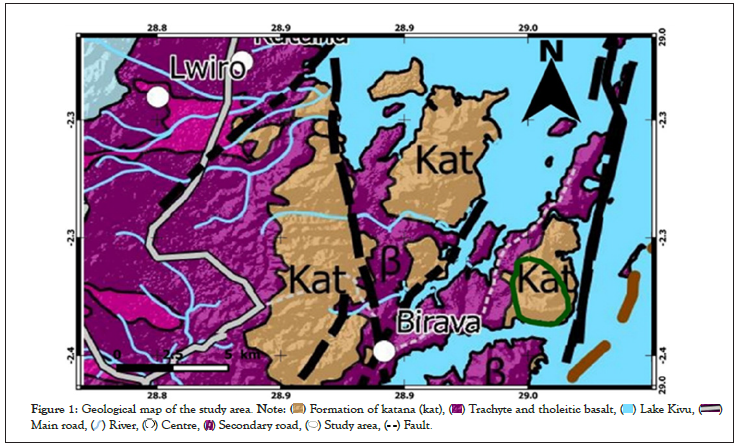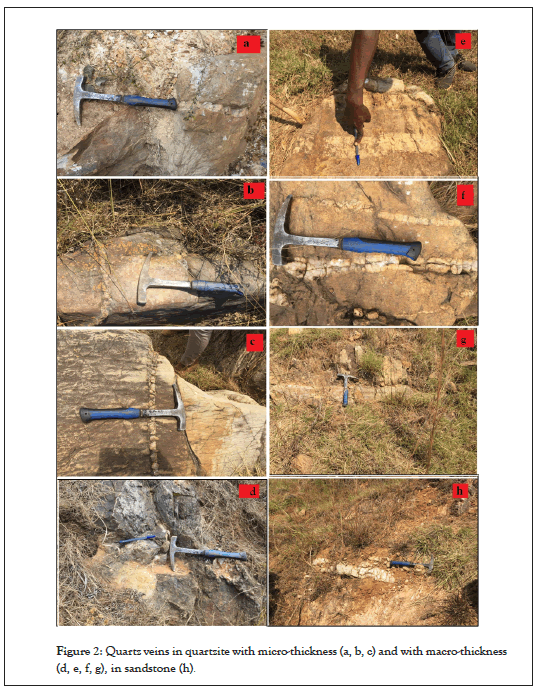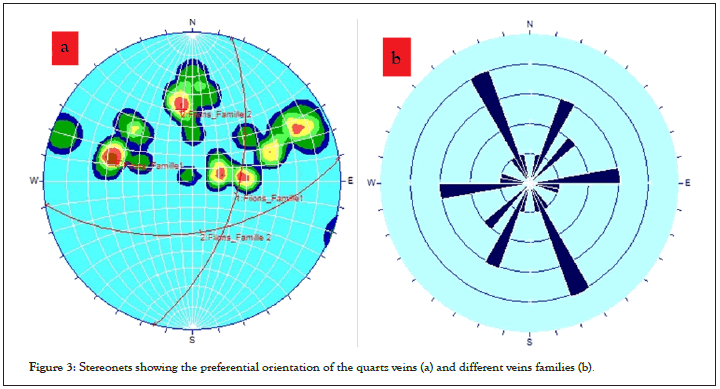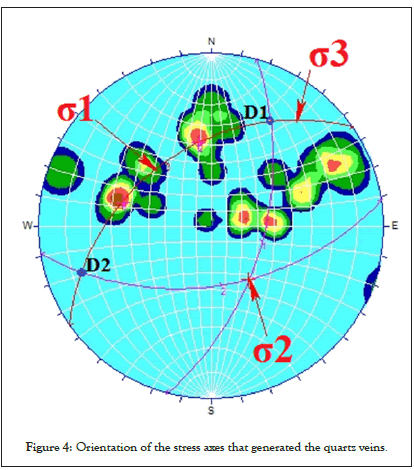Journal of Geology & Geophysics
Open Access
ISSN: 2381-8719
ISSN: 2381-8719
Short Communication - (2022)Volume 11, Issue 6
The present study was made on the quartz veins of Precambrian rocks basement of the hill of Ludjo, eastern DR Congo in order to determine their preferential orientation and to compare this orientation with the different orientations of other different structures in the region. To achieve this, the field investigations were carried out with care, the veins were described; estimated vein thicknesses, and structural measurements were taken and processed for the determination of preferential orientation. The results of the research have shown that the quartz veins on the hill of Ludjo are either of micro-thickness (5-10 cm) or macro-thickness (10-20 cm). Macro-veins are most often found in quartzites which are abundant in the study area. These quartz veins exhibit an NNE-SSW preferential orientation that intersects with the Meta-Kibara formations and the quartz veins of Precambrian Numbi formations.
Quartz-veins; Precambrian rock basement; Quartzite; Ludjo; Eastern DR Congo
The Ludjo hill is located in the Lugendo locality, which extends to the western side of Lake Kivu, 35 km from the Bukavu town by the Birava-Amsar road. Located in the chiefdom community of Kabare, rural territory of Kabare, Province of South Kivu in the Eastern Democratic Republic of the Congo, the map of the geology of Kivu according to Lagmouch, et al. [1], places our study area in the Katana formations (Figure 1), which consist mainly of graphite black schists, red schists, quartzites, sandstone with ferruginous laminae and conglomerate sandstones showing a generally weak metamorphism and Structural directions directed N to NE corresponding to two superimposed tectonics, the last giving NS folds. They are apparently covered in discordance by the characteristic mix of the Tshibangu Group(VILLENEUVE, unpublished) [2], and intruded by the Nyamakubi granite (whose probable age of intrusion is the same as the other "tin granites" of the region, ie 976 ± 10 m.a, but whose isotopic balance has been disturbed by more recent events [3].

Figure 1: Geological map of the study area. Note:  Formation of katana (kat),
Formation of katana (kat),  Trachyte and tholeitic basalt,
Trachyte and tholeitic basalt,  Lake Kivu,
Lake Kivu,  Main road,
Main road, River,
River,  Centre,
Centre,  Secondary road,
Secondary road,  Study area,
Study area,  Fault.
Fault.
In situ measurements of strikes and dips of the principal quartz veins were taken with compass clinometers. This will later help to deduce the direction of the tectonic forces that produce some structural elements observed in the area. The thickness of veins has been estimated using some field materials as geological hummer and pen. Measured structural parameters were integrally statistically processed using Dips Software. Stereonets have been made and the constraint axes including: σ1, σ2 and σ3 have been established in order to determine the deformation axes that generated pegmatites veins in the study area.
Structural inputs of the quartz veins
Generally, in the study area, the main fractures are filled with quartz, which is easy to detect because of its hardness, erosion resistance and shiny to bold luster. The quartz veins occur and cut- crossing mostly the quartzites (Figures 2a-2f), rarely the sandstones (Figures 2g and 2h). These quartz veins are more abundant in the northern part of the study area. These quartz veins are either micro-veins (majority with thickness <10 cm) (Table 1, Figures 2a-2c) or macro-veins (large veins; veins thicker than 10 cm, Figures 2d-2h). The Stereonet in Figure 3a shows the different families of the quartz veins within the area and the stereogram in the Figure 3b shows the general orientation of quartz veins ranging from N150°E to N160°E, showing the NNE-SSW trend. Table 1 shows a list of the structural measurements of quartz veins.

Figure 2: Quartz veins in quartzite with micro-thickness (a, b, c) and with macro-thickness (d, e, f, g), in sandstone (h).

Figure 3: Stereonets showing the preferential orientation of the quartz veins (a) and different veins families (b).
| N° | Latitude | Longitude | Strike | Dip | Thickness |
|---|---|---|---|---|---|
| 1 | 9742856 | 0716797 | N50°E | 5°NE | 16 cm |
| 2 | 9742856 | 0716780 | N90°E | 70°NE | 10 cm |
| 3 | 9742826 | 0716777 | N20°E | 40°NW | 8 cm |
| 4 | 9742436 | 0716724 | N150°E | 80°SE | 14 cm |
| 5 | 9742384 | 0716772 | N42°E | 50°NE | 17 cm |
| 6 | 9742222 | 0716963 | N42°E | 60°NW | 12 cm |
| 7 | 9742205 | 0717012 | N100°E | 60°NE | 6 cm |
| 8 | 9742205 | 0717012 | N20°E | 85°ENE | 5 cm |
| 9 | 9742556 | 0717688 | N160°E | 20°SE | 5 cm |
| 10 | 9742462 | 0717858 | N80°E | 60°NW | - |
| 11 | 9742465 | 0717880 | N85°E | 48°NE | 10 cm |
| 12 | 9742461 | 0717923 | N175°E | 40°NE | 6 cm |
| 13 | 9742455 | 0718033 | N80°E | 55°NE | 20 cm |
| 14 | 9742417 | 0718580 | N91°E | 35°W | 8 cm |
| 15 | 9742379 | 0718522 | N20°E | 58°NW | 10 cm |
| 16 | 9742317 | 0718167 | N140°E | 50°NE | 4 cm |
| 17 | 9742049 | 0718403 | N180°E | 40°NW | 10 cm |
| 18 | 9742379 | 0718522 | N20°E | 58°NW | 4 cm |
| 19 | 9742491 | 0718393 | N161°E | 56°NE | 10 cm |
| 20 | 9742491 | 0718393 | N150°E | 70°NE | 8 cm |
| 21 | 9742379 | 0718522 | N10°E | 60°NNW | 4 cm |
| 22 | 9742489 | 0718413 | N159°E | 80°NW | 12 cm |
| 23 | 9742494 | 0719718 | N139°E | 25°NW | 3 cm |
| 24 | 9742490 | 0718454 | N159°E | 60°NW | 3 cm |
| 25 | 9742459 | 0718501 | N168°E | 30°W | |
| 26 | 9742417 | 0718580 | N180°E | 18°W |
Table 1: Structural measurements of quartz veins in Ludjo.
The stereogram on the Figure 4 shows two clouds of poles that represent the plans. These two clouds represent the two of the main families (groups) of the veins mentioned above. There are also two large circles drawn respectively at the poles of the averages of the elements of each of the two families. The direction and dip values of these two averages are respectively N15°E/55°E (Group1) and N80°E/50°SSE (Group 2). The overlap of these two large circles allows us to say that the two families of the veins are conjugated and we can determine the principal stresses that generated the deformation within zone. The intersection of these large circles represents the normal component intermediate σ2. The strike and plunge of σ2 are N235°E/41°SE.

Figure 4: Orientation of the stress axes that generated the quartz veins.
The stereogram shows that the large circle of which σ2 is the pole, carries the maximum normal principal stress σ1 (sigma1 on the diagram), the minimum normal principal stress σ3 (sigma3 on the diagram), the principal tangential stress ζmax (Tmax on the canvas) and sliding directions D1 and D2. This big circle is the sliding plane. D1 and D2 are the intersections of two large circles representing the families with the slip plane; their directions and plunge are respectively N119°E/68°NNE and N339°E/76°WSW. In the middle of D1D2 we find sigma1 direction and dipping N049°E/048°NW. At 90° of sigma1 we find sigma3 direction and dipping N130°E/76°NNE and in the middle of σ1σ3 found Tmax direction and dipping N094°E/55°N.
The acute angle formed by the two large circles representing the families is the angle 2α equal here to 70° which allows us to find the internal friction angle equal to 90°-2α=90°-55°=35°. The value of the internal friction angle being positive in the study area, this allows us to know that the study area is stable to the rock masse movements.
Briefly, the selected study area includes extensive fracturing, characterized by micro and macro quartz veins preferentially oriented NNE-SSW. Compared to other quartz vein directions zithin the region; Ludjo veins display the same preferential direction with the Kaziba sills in the Itombwe synclinorium [4], and same direction with the first family of veins filled with silica and iron oxide that have been found in geological lithologies from Ntondo- Nyamurhale areas [5]. The direction of the Ludjo quartz veins is secant to the Kibara meta-sedimentary formations (NNW-SSE) [6], secant also to the tourmaline and wolframite quartz veins found in the geological formations from the North part of Idjwi [7], secant to gold quartz veins from Ntula area [8], and to the quartz veins found in the Precambrian formations from Numbi in Kalehe [9,10]. These Ludjo quartz veins show an orientation perpendicular to the quartz veins found by Prosper, et al. [11], in granitic geological formations of Bushushu, in Kalehe district.
Field investigations have shown that the quartz veins of the Ludjo sector appear in micro-veins with a size ranging from 5 to 10 cm and in macro-veins with a size ranging from 10 to 20 cm; mostly in quartzite formations which are also more predominant in the study area. They exhibit an average NNE-SSW preferential orientation which has been compared to various other orientations of other quartz veins encountered in the region, and which generally secant to the Kibara metasediments. This general orientation of the quartz veins can undoubtedly serve as a guide for future investigations in the region as well as the selected study area has been subjected of artisanal mining activities in the past period.
The authors declare that they have no conflict of interest.
Citation: Parfait MM, Barry AD (2022) Structural Inputs of Quartz Veins on the Precambrian Basement Rocks form Ludjo, Birava, Eastern DR Congo: General Overview. J Geol Geophys. 11:1036.
Received: 08-Jul-2022, Manuscript No. JGG-22-18578; Editor assigned: 11-Jul-2022, Pre QC No. JGG-22-18578 (PQ); Reviewed: 25-Jul-2022, QC No. JGG-22-18578; Revised: 01-Aug-2022, Manuscript No. JGG-22-18578 (R); Published: 08-Aug-2022 , DOI: 10.35248/2381-8719.22.11.1036
Copyright: © 2022 Parfait MM, et al. This is an open-access article distributed under the terms of the Creative Commons Attribution License, which permits unrestricted use, distribution, and reproduction in any medium, provided the original author and source are credited.